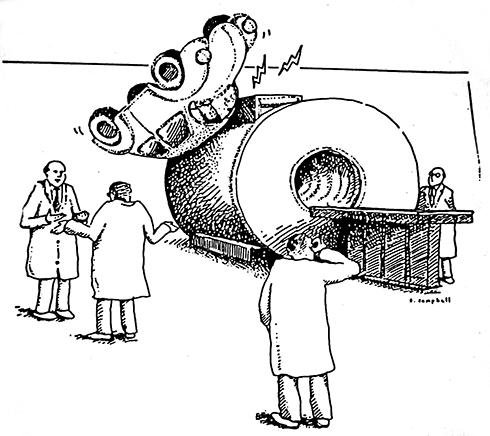
Archived news, videos, articles and items of interest.
Return to Current News Items
Follow us on Facebook, Twitter and Instagram.



January 2017 - Safety Information
Having many years of MRI experience behind us, we can't help being perturbed by the amount of mis-information and inaccurate portrayal of MRI in movies and television. We so often see characters entering the MRI magnet room, flipping a switch to turn the magnet on, and then having metal objects flying across the room.
While it is true that the magnet is very powerful and will attract loose metal objects, it is a myth that the machine can be easily turned on and off. It took a couple of days to "ramp up" the magnet by applying an external power source to it, back in December. Now that the magnet is energized, we cannot easily turn it off. And if we did, it would take a couple of days and over $50,000 to turn it back on. Thus we have to be very careful that nothing metal that can be attracted to magnet is brought into the room. All people entering the magnet room must be dressed in MRI-compatible clothing (all patients are asked to change into our specifically sourced gowns and scrubs) and then checked to make sure nothing ferrous is on them. Only ferrous metals are attracted to the magnet, and we check every metal item with a powerful hand magnet to insure that they won't become projectiles once in the room.

Sticking a large metal object to the magnet would pose real problems with getting it off again, as the attractive force is so strong that even a small object like a wrench would take several thousand pounds of force to remove it.
Another situation that is inaccurately portrayed in the media is that patients with implants will have that implant pulled from their body. This is not true, as most implants are either non-magnetic or anchored so securely that no harm can come from them. There are some items, though, that could pose a risk to the individual. Every person that is required to enter the magnet room needs to fill in an MRI screening form. The information we ask on it is essential for the safety of the person entering the room. Some implanted devices such as pacemakers, cerebral aneurysm clips, inner ear prosthesis, or other mechanical devices may be rendered inoperable by the MRI or moved slightly from position causing internal damage. We would have to obtain the exact make and model of these devices and contact the manufacturer to determine if they can be safely scanned. Therefore, the more information you can provide us regarding your surgical history, the easier we can determine if there are any safety risks for you to undergo an MRI. Sometimes it may take some time for us to acquire the information to insure your safety. We ask for your patience in these cases.

This is my arm with both steel and titanium hardware in place. The steel is mildly attracted to the magnet, but anchored so well into the bone it causes no discomfort at all, while the titanium is completely unattracted to the magnet and can be scanned with no issues. The steel causes artifacts on convential MRI scans, however we have a specialized type of scan that can eliminate the artifacts from metal and allow a diagnosis where other MRI scans cannot.
If you have any questions about the safety of implants that you may have in your body, or require other information about MRI safety, please feel free to e-mail us at: mri@peacemri.com and we would be happy to respond.